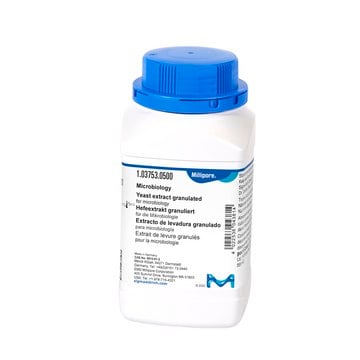72073
Soda lime
p.a., with indicator, pellets
Seleccione un Tamaño
Seleccione un Tamaño
About This Item
Productos recomendados
grado
p.a.
Nivel de calidad
Formulario
pellets
calidad
with indicator
pérdida
13-18% loss on drying, 105 °C
tamaño de partícula
2-5 mm
pH
7-14
capacidad
≥27 % absorption capacity (CO2)
densidad aparente
~75 g/100 mL
cadena SMILES
[OH-].[Na+].O=[Ca]
InChI
1S/Ca.Na.H2O.O/h;;1H2;/q;+1;;/p-1
Clave InChI
HUAUNKAZQWMVFY-UHFFFAOYSA-M
¿Está buscando productos similares? Visita Guía de comparación de productos
Categorías relacionadas
Descripción general
Aplicación
- As a hydrolysis reagent in the synthesis of bentazone from isatoic anhydride.
- In the monitoring of CO2 efflux from field soils.
- In the direct measurement of dissolved CO2 (carbon dioxide) in supersaturated water.
Palabra de señalización
Danger
Frases de peligro
Consejos de prudencia
Clasificaciones de peligro
Eye Dam. 1 - Met. Corr. 1 - Skin Corr. 1 - STOT SE 3
Órganos de actuación
Respiratory system
Código de clase de almacenamiento
8B - Non-combustible corrosive hazardous materials
Clase de riesgo para el agua (WGK)
WGK 1
Punto de inflamabilidad (°F)
Not applicable
Punto de inflamabilidad (°C)
Not applicable
Equipo de protección personal
Eyeshields, Faceshields, Gloves, type P3 (EN 143) respirator cartridges
Elija entre una de las versiones más recientes:
¿Ya tiene este producto?
Encuentre la documentación para los productos que ha comprado recientemente en la Biblioteca de documentos.
Los clientes también vieron
Active Filters
Nuestro equipo de científicos tiene experiencia en todas las áreas de investigación: Ciencias de la vida, Ciencia de los materiales, Síntesis química, Cromatografía, Analítica y muchas otras.
Póngase en contacto con el Servicio técnico













